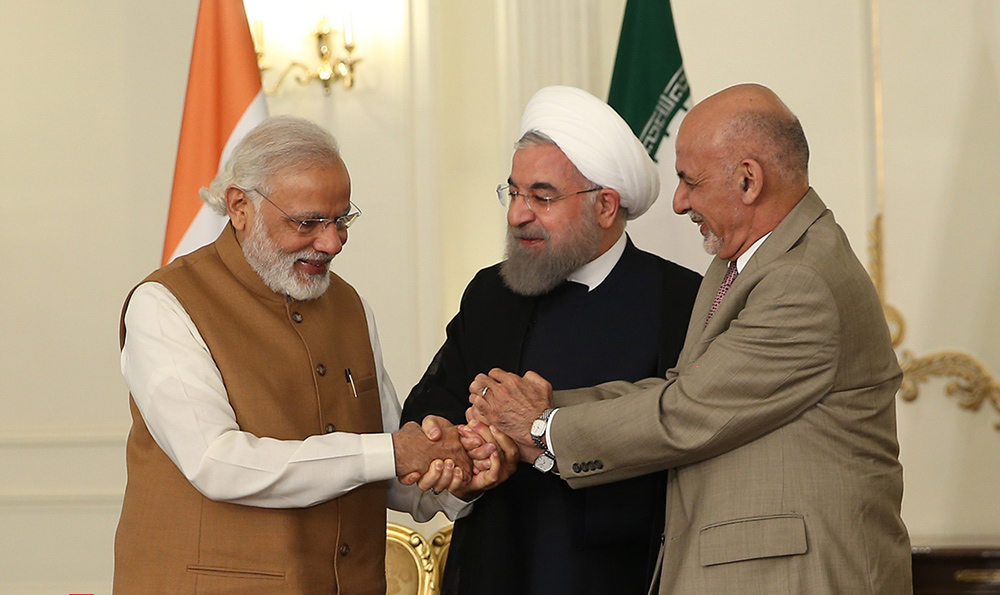During his recent visit to Japan, Indian Prime Ministers Narendra Modi and Shinzo Abe welcomed the prospects of cooperation between the two countries for promoting peace and prosperity in the region. This, as agreed upon by both countries, would be done through bilateral and trilateral cooperation, inter-alia, in the development of infrastructure and connectivity for Chabahar, the port in southeastern Iran, reads an article published by the Indian news organization Firstport. Below is an excerpt.
The trilateral engagement between India, Iran and Afghanistan during Modi’s visit to Iran in May 2016 was historic, expanding avenues of trade for India with Iran, Afghanistan, Central Asia and Russia through the International North-South Transportation Corridor.
Chabahar is Iran’s only oceanic port and consists of two separate ports named Shahid Kalantari and ‘Shahid Beheshti, each of which has five berths – overall 10 berths. India and Iran first agreed on plans to further develop Shahid Beheshti port in 2003, but India was deterred by the sanctions against Iran. Under the Indo-Iranian agreement of May 2016, India would refurbish one of the berths at Shahid Beheshti, and reconstruct a 600-meter long container handling facility at the port.
The bilateral agreement between India and Iran gives the latter the right to develop two berths of the Chabahar Port as agreed in 2015, allowing them to be operated for 10 years by India Ports Global, which is a joint venture between Jawaharlal Nehru Port Trust and Kandla Port Trust, in partnership with Iran’s Aria Banader.
Along with the development of Chabahar port, India is also to construct a railway line linking Chabahar with Zahedan on the Iran-Afghanistan border, which beyond Zahedan will be linked to the Iranian Railway running west and then north close to the Iran-Afghanistan border, avoiding the volatile Helmand Province of Afghanistan.
India’s development of Chabahar will be at a cost of $85 million over the course of 18 months. Upon completion of upgrade works as agreed to in May 2016, Chabahar’s capacity will be increased to 8 million tons from the current 2.5 million tons. India’s investment is supplemented with a $150 million credit line to Iran through Exim Bank of India. India has also offered to supply $400 million worth of steel for the construction of the rail link Chabahar-Zahedan.
Chabahar port and the INSTC give India the strategic access for trade with Afghanistan and Eurasia, faced with denial of the land route by Pakistan. Recent operationalising of Gwadar port, as well as the CPEC, makes this even more significant. Gwadar port has been leased for operations to a Chinese company for 49 years. In December 2011, regional Pakistani newspapers reported Chinese military taking over Gilgit-Baltistan and Pakistan considering leasing Gilgit-Baltistan to China for 50 years.
Iran’s recent refusal to accept the proposal by ONGC Videsh to develop Iran’s Farzad-B oilfield at a cost of $10 billion doesn’t bode well. This agreement was to be signed in October 2016. The 12.8 trillion cubic feet of gas reserves named Farzad-B was discovered by a consortium of OVL, Oil India Ltd and Indian Oil Corporation in 2008. Though India is still hopeful of pulling off the deal by February 2017, Iran’s action may have been influenced by China.
Building China Ties
In 2011, Beijing and Tehran signed a deal giving China exclusive rights to several multiple Iranian oil and gas fields through 2024, including rights to build necessary infrastructures. In return, China promised to treat any foreign attack against these regions as attacks against its own sovereign territory, and defend them as such. China and Iran aim to increase bilateral trade to $600 billion within the next decade, even though economists feel it is not attainable.
There may be multiple reasons why India refrained from developing Chabahar after agreeing to do so in 2003, but it did emerge in 2015 that there were problems in clearing backlog payments for imported Iranian oil even through European banks because of the sanctions.
When India physically commenced developing Chabahar and how much has been completed is not known, there is clearly need for speed, in addition to quality.
Early leveraging the Indo-Japanese partnership into the project and ironing out problems of fiscal investment, if any, on account of continuing sanctions (of whatever form) is the need of the hour. Considering that the development work by India was to be completed in 18 months, it should actually aim to deliver it by September 2017.


